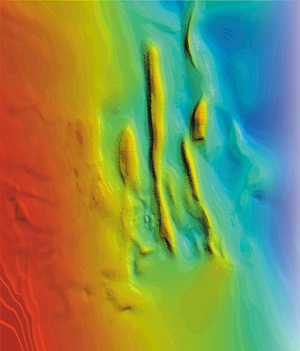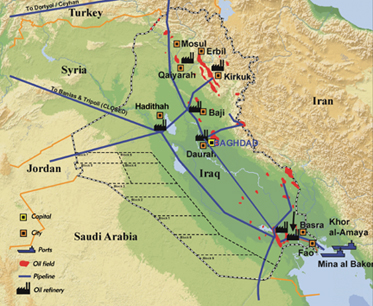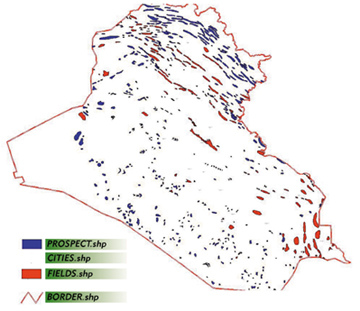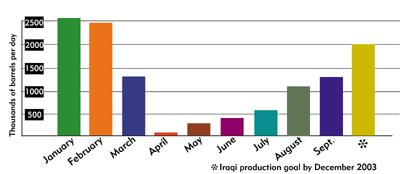Geotimes

Feature
Assessing Iraq’s
Oil Potential
Mohammad Al-Gailani
Sidebar:
War Numbers
Iraq is one of the most hydrocarbon-rich countries in the Middle East, and
in the future, it could become one of the primary oil producers in the world.
A thick sedimentary succession (from Cambrian to Recent), robust structures,
high individual well productivity and extensive oil reserves are some of the
main characteristics of Iraqi oil fields.
 The latest
estimates put Iraq’s potential reserves at around 150 to 200 billion barrels
of oil and 106 trillion cubic feet of gas. These figures put Iraq in the forefront
of oil-producing countries: Iraqi oil reserves are considered to be the second
largest in the world, after Saudi Arabia’s.
The latest
estimates put Iraq’s potential reserves at around 150 to 200 billion barrels
of oil and 106 trillion cubic feet of gas. These figures put Iraq in the forefront
of oil-producing countries: Iraqi oil reserves are considered to be the second
largest in the world, after Saudi Arabia’s.
The super-giant fields of southeastern
Iraq are the largest concentration of super-giants to be found anywhere in the
world. Part of the upper Jurassic-aged Gotnia reflector, based on 1980s 2-D
seismic data, they are, from left to right and top to bottom, as follows: Ratawi;
Rachi; West Qurna; North and South Rumaila (measuring over 117 kilometers long);
Tuba; Zubair; Majnoon; and Nahr Umr Fields. All images courtesy of Mohammad
Al-Gailani.
Unfortunately, unlike neighbor Saudi Arabia, Iraq has been unable to deploy
the latest technology, such as 3-D seismic, to find its reserves. Present reserve
estimates of Iraq’s oil are based on 2-D seismic technology from the 1980s.
Still, the estimated success rate in Iraq ranges from one in two in the Mesopotamian
Basin to one in four in the western and northwestern stable platform, with the
overall success rate exceeding 72 percent — perhaps the highest success
rate achievable anywhere in the world. Oil exploration costs are among the cheapest
globally, with the current cost estimated at around 50 cents per barrel.
We now know that Iraq’s past governmental practices of nationalization
and central planning are incompatible with the fast-track approach now required
to meet future potential reserves requirements for the new millennium —
especially in the light of the huge national debt accumulated as a result of
three Gulf wars and prolonged sanctions. Work must start immediately to regain
the prewar production capacity of 3.5 million barrels of oil per day. Then Iraq
can slowly move up to its planned future production target of 6 million barrels
of oil per day.
Past success
Oil and gas exploration drilling in Iraq began in 1902, with a well sunk on
an anticlinal structure at Chia Surkh, located in the Zagros region in central
northeast Iraq, near the Iranian border. In 1919, appraisal drilling started
in the Naft Khana area, resulting in the discovery of the first oil field in
1923. Then four years later, a turning point for exploration drilling occurred
in Iraq: In 1927, the Iraq Petroleum Company (IPC) drilled the first well, on
the Kirkuk structure (specifically on the Baba Dome, the southernmost culmination
on the Kirkuk structure). The well, Baba Gurgur No. 1, struck oil in dramatic
fashion: An uncontrolled gusher, which reached 50 feet above the derrick, drenched
the surrounding countryside and threatened nearby villages and the town of Kirkuk.
After nearly nine days, the well workers finally brought it under control. Before
capped, however, it had flowed at 95,000 barrels per day.
Despite its success at Kirkuk, IPC focused its primary exploratory efforts prior
to World War II in the region farther southeast, in the Iranian Zagros Foldbelt.
When exploration resumed after World War II, IPC discovered the Zubair Field
in 1948 and the Rumaila Field in 1953. Renewed exploration in the foldbelt led
to the discovery of oil at Bai Hassan (1953) and Jambur (1954) — leading
to the discoveries of many other oil fields in Iraq prior to the suspension
of IPC’s exploration activities in 1961.
After the passing of Law No. 80 in 1960, the Iraqi National Oil Company (INOC)
initiated its own drilling plans for developing the discovered fields. Their
extensive exploration and drilling was sufficient to cover the entire country.
By 1988, the number of exploratory wells drilled totaled 125.
Although IPC estimated in 1968 that the total recoverable reserves of oil in
Iraq was about 36 billion barrels, experts now consider those early figures
very much an underestimate. Even at that time, Iraq put the reserves at 60 billion
barrels, based on the primary producing fields of Rumaila, Kirkuk and some other
smaller fields. However, because both these figures exclude many minor producing
horizons, experts consider reserve assessments for the country on the conservative
side; there is probably much more oil in place than has been declared. Even
relatively small oil fields like Butmah and Ain Zalah easily qualify as giant
oil fields, but these are dwarfed by Iraq’s super-giants, the Kirkuk, Rumaila,
East Baghdad and Majnoon Fields.
Underlying geology
Over the past few decades, geologists have studied the sedimentary history
of Iraq, achieving a reasonably good understanding. Two features dominate the
sedimentary record of the area: the Arabian Shield to the west and the Tethyan
passive margin/Zagros collision zone to the east.
 The sedimentary
history of Iraq also exhibits a variety of ages in different areas as a result
of a series of epeirogenic (tectonic) cycles, especially in the western and
central parts of Iraq. Orogenic movements are more characteristic of the northern
and northeastern parts of Iraq.
The sedimentary
history of Iraq also exhibits a variety of ages in different areas as a result
of a series of epeirogenic (tectonic) cycles, especially in the western and
central parts of Iraq. Orogenic movements are more characteristic of the northern
and northeastern parts of Iraq.
The first well was drilled in Iraq in
1927 at the Kirkuk structure. Since then, geologists have discovered 73 major
fields, nine of which are super-giants and 22 of which are giants.
Virtually all of the 440,000 square kilometers of Iraq lie within the North
Arabian Basin. This vast sedimentary basin extends from the Arabian-Nubian Platform
in the west to the alpine-folded Zagros Mountains in the east. It dates from
the Precambrian and contains more than 15 kilometers of Infra-Cambrian to Recent
sediments.
Prolific source rock, reservoir and seal rock combinations occur throughout
the geologic column. A lack of source rocks is not expected to be a problem
in Iraq because of numerous and rich hydrocarbon indications present at exploratory
drilling sites. The differences in oil accumulations between the various tectonic
areas of Iraq mainly relate to size and closure of structures, and also to reservoir
development/facies distribution, but not to the absence of source rocks or seals.
To date, petroleum geologists have delineated and mapped over 526 prospects
— drilling 131 prospects to discover 73 major fields. They have identified
some 239 as having a high degree of certainty, but those prospects remain undrilled.
Thirty fields have been partially developed and only 12 fields are actually
onstream. Undrilled structures and undeveloped fields could represent the largest
untapped hydrocarbon resource anywhere in the world.
About 30 to 40 percent of discovered Iraqi oil reserves lie within a few thousand
feet of the surface, while more than 60 percent of the discovered reserves lie
within 10,000 feet. Most of Iraq’s proven oil reserves are distributed
over 73 fields, nine of which are super-giants and 22 of which are giants. The
remainder are considered large by world standards.
Most of the developed reservoirs are of Cretaceous age. These account for approximately
76 percent of total production, while Tertiary production represents around
23.9 percent. The remaining 0.1 percent of production comes from the Jurassic,
Triassic and Ordovician.
Looking to the future
The removal of the sanctions on Iraq will present exciting exploration opportunities.
Geologists expect the exploration effort to concentrate on areas with high potential,
relying on collaboration between the Iraqi authority and international oil companies,
on a production sharing risk contract basis — in which contracted companies
would give technical and financial services for exploration and development
operations in exchange for a stipulated share of the oil produced (a reward
for the risk taken and services rendered).
One area being promoted now for this new collaborative strategy is the western
desert, an area well-advertised for its availability of exploration blocks.
The initial investment required per block is estimated at around $50 million,
to cover several thousand line kilometers of seismic exploration and the drilling
of a minimum of five exploration wells per block. Other production sharing agreements
would include additional geophysical, geological and exploration drilling activities
for the development of the giant fields carried out by international oil companies.
Oil experts and specialists on the Iraqi scene believe that a gradual buildup
of exploration work will take place immediately after the establishment of a
legitimate Iraqi authority. This will likely include the deployment of up to
10 2-D and 3-D seismic survey parties and up to 10 exploratory rigs per year,
in order to achieve the production target of up to 6 million barrels of oil
per day.
The aim of any future exploration strategy will be to maintain reserve replacement
of around 2 billion barrels per year. This could be achieved by implementing
the following strategy:
* carrying out extensive 2-D and 3-D seismic explorations on all the green
fields as well as on the untested prospects;
* drilling the nearly 400 remaining untested structural anomalies;
* expanding the deep drilling programs and utilizing proven oil reserves
in deep horizons;
* targeting the new Palaeozoic plays in the western desert, especially in
light of the recent discovery at Salah Aldin (Akkas);
* and targeting potential stratigraphic traps within the Cenozoic, Mesozoic
and Palaeozoic sections that have proven potential. |
 Iraq
has the capability to reach a production plateau of 5 to 6 million barrels of
oil per day within a relatively short period of time — by expanding the
number of producing oil fields and by developing the promising central sector
fields, such as East Baghdad, Balad and Ahdeb, as well as the newly appraised
fields in the north, such as Hamrin, Saddam, West Tikrit and Khurmala. Presently,
Iraq’s production comes from only 15 developed fields out of a potential
73 discovered fields.
Iraq
has the capability to reach a production plateau of 5 to 6 million barrels of
oil per day within a relatively short period of time — by expanding the
number of producing oil fields and by developing the promising central sector
fields, such as East Baghdad, Balad and Ahdeb, as well as the newly appraised
fields in the north, such as Hamrin, Saddam, West Tikrit and Khurmala. Presently,
Iraq’s production comes from only 15 developed fields out of a potential
73 discovered fields.
Petroleum geologists have delineated and
mapped more than 526 prospects, drilling 131 prospects to discover 73 major
fields. Some 239 undrilled prospects have a high degree of certainty. Thirty
fields have been partially developed and 12 fields are actually onstream.
Iraq needs to develop the remaining 58 fields; the other 15 developed fields
may require further investment to enhance their potential. This strategy would
require the drilling of thousands of new wells over a span of five to 10 years,
as well as the installation of new surface facilities (gathering centers, tank
farms, pipelines, etc.).
The 15 developed fields present an immediate target for further enhancement
and expansion to increase present production levels by at least 1 million barrels
of oil per day. New project management schemes and reservoir simulation studies
(with the help of international oil companies supplying and installing new equipment
and providing oil field services) are necessary to increase present production
levels. An estimate of the initial capital cost required is about $4,000 per
barrel of daily production (i.e. $400 million initial costs for a field that
can produce 100,000 barrels per day), or perhaps less, if the facilities and
the infrastructure needed for storage and transportation of the crude already
exist.
The development of major new reservoirs within existing fields is an attractive
prospect for foreign investment because the infrastructure and facilities are
already in place. The most obvious targets for development are the middle Cretaceous
Mishrif reservoir and the lower Cretaceous Yamama reservoir in the southern
fields, the Jurassic Najmah reservoir in the Rumaila and West Qurna Fields,
and the Cretaceous reservoirs in the northern fields.
The 58 undeveloped fields, including giant fields such as Majnoon, Nahr Umr,
Halfaya and West Qurna, are available for immediate development under production
sharing agreement terms. Roughly $10 billion is necessary to develop 2 million
barrels of oil per day over an eight to 10 year period, with the possibility
of initial revenue being generated within two years using existing facilities.
A further 20 large- to medium-sized fields, with a production capacity of 1.5
million barrels of oil per day, can be developed relatively easily since they
are located near existing production centers at Kirkuk, Baghdad and Basra.
High prospects
Clearly, large parts of Iraq are still virgin — its large hydrocarbon
reserves are still waiting to be developed to their full potential, while most
other Middle East countries are fully exploiting their reserves.
The main challenges facing the new Iraqi authority are to establish law and
order as well as security. Once these issues are resolved, Iraq will perhaps
be the most exciting place on Earth with regard to oil development and exploration.
Despite the reported loss and destruction of rock core and seismic data in the
aftermath of the recent conflict, several private companies have such data archived.
And much of what was lost was old data in need of replacement — additional
incentive to deploy the latest 3-D seismic technology to add to and rebuild
the national exploration archives.
International oil companies are looking forward with great anticipation to the
opening of Iraq, as they have been waiting for the past 40 years. Hopefully,
Iraq will soon be able to offer them acreage, thereby allowing proper development
of its huge potential. Open and fair competition will enable oil companies to
apply the latest technologies in the search for, and development of, the country’s
hydrocarbon resources — thus helping Iraq realize its full hydrocarbon
potential.
|
War Numbers
| Estimated
Damage Assessment from Stratfor Services
War-related as of mid-July...........................................$250-350
million
Looting from mid-March 2003 through mid-July
2003.....$750 million*
*Excludes costs of recent and frequently sophisticated
sabotage attacks and looting
|
It has been a tumultuous year in Iraq, and a tumultuous year in the oil
markets. Prior to the commencement of the war in Iraq in March 2003, the
Department of Defense designated the U.S. Army Corps of Engineers as Executive
Agent of a project to repair any damage to and, continue operations of,
the Iraqi oil infrastructure. The Army Corps, in conjunction with civilian
commercial contractors, has been working since then to stabilize the Iraqi
oil infrastructure and assess damages. In August, the Corps closed the application
period for companies bidding on contracts to continue to repair and maintain
oil operations in Iraq this fall into next year. Opportunities for contracts
should open in mid- to late-October. The Corps finished its initial assessment
of war-related damage to the Iraqi oil complex in July.
Experts predict stabilizing and
slightly declining oil prices over the next year, as Iraqi production slowly
picks up the pace and the Organization of Petroleum Exporting Countries
(OPEC) adjusts production in other member states. As Iraq boasts the world’s
cheapest lifting and transport costs, experts agree that it is essential
for the country to maximize production as soon as possible.
2003 Iraq Oil Production Information from the Energy Information Administration
 Iraq
hopes to expand production to 2.0 million barrels of oil per day (bpd) by
December 2003, 2.8 million bpd by April 2004 and 6.0 million bpd by 2010.
Expanding production has already been slower than anticipated, as the rebuilding
faces frequent sabotage and looting, outdated oil technology, theft of crude
oil, and ongoing security issues with the main pipeline that crisscrosses
the nation. Iraq
hopes to expand production to 2.0 million barrels of oil per day (bpd) by
December 2003, 2.8 million bpd by April 2004 and 6.0 million bpd by 2010.
Expanding production has already been slower than anticipated, as the rebuilding
faces frequent sabotage and looting, outdated oil technology, theft of crude
oil, and ongoing security issues with the main pipeline that crisscrosses
the nation.
According to a U.S. State Department press release, the Department of Defense
estimates the potential oil income to the Iraqi people at $20 billion to
$30 billion per year. A percentage of that will be used to rebuild Iraq,
the release says.
Megan Sever
Back to top |
Al-Gailani is managing director
of GeoDesign Limited, a consultancy office based in London that specializes in
Middle East databases. Previously, he has worked as an independent consultant
on several projects in the Middle East and in South America, as well as for the
Iraqi National Oil Company in Baghdad. He graduated from Baghdad University in
1972 with a bachelor’s degree in geology and worked briefly for the Iraqi
National Oil Company in Baghdad. He later received his master’s degree from
the University of Aberdeen and his Ph.D. from Imperial College in London.
Back to top
 The latest
estimates put Iraq’s potential reserves at around 150 to 200 billion barrels
of oil and 106 trillion cubic feet of gas. These figures put Iraq in the forefront
of oil-producing countries: Iraqi oil reserves are considered to be the second
largest in the world, after Saudi Arabia’s.
The latest
estimates put Iraq’s potential reserves at around 150 to 200 billion barrels
of oil and 106 trillion cubic feet of gas. These figures put Iraq in the forefront
of oil-producing countries: Iraqi oil reserves are considered to be the second
largest in the world, after Saudi Arabia’s. 
 The sedimentary
history of Iraq also exhibits a variety of ages in different areas as a result
of a series of epeirogenic (tectonic) cycles, especially in the western and
central parts of Iraq. Orogenic movements are more characteristic of the northern
and northeastern parts of Iraq.
The sedimentary
history of Iraq also exhibits a variety of ages in different areas as a result
of a series of epeirogenic (tectonic) cycles, especially in the western and
central parts of Iraq. Orogenic movements are more characteristic of the northern
and northeastern parts of Iraq. Iraq
has the capability to reach a production plateau of 5 to 6 million barrels of
oil per day within a relatively short period of time — by expanding the
number of producing oil fields and by developing the promising central sector
fields, such as East Baghdad, Balad and Ahdeb, as well as the newly appraised
fields in the north, such as Hamrin, Saddam, West Tikrit and Khurmala. Presently,
Iraq’s production comes from only 15 developed fields out of a potential
73 discovered fields.
Iraq
has the capability to reach a production plateau of 5 to 6 million barrels of
oil per day within a relatively short period of time — by expanding the
number of producing oil fields and by developing the promising central sector
fields, such as East Baghdad, Balad and Ahdeb, as well as the newly appraised
fields in the north, such as Hamrin, Saddam, West Tikrit and Khurmala. Presently,
Iraq’s production comes from only 15 developed fields out of a potential
73 discovered fields. Iraq
hopes to expand production to 2.0 million barrels of oil per day (bpd) by
December 2003, 2.8 million bpd by April 2004 and 6.0 million bpd by 2010.
Expanding production has already been slower than anticipated, as the rebuilding
faces frequent sabotage and looting, outdated oil technology, theft of crude
oil, and ongoing security issues with the main pipeline that crisscrosses
the nation.
Iraq
hopes to expand production to 2.0 million barrels of oil per day (bpd) by
December 2003, 2.8 million bpd by April 2004 and 6.0 million bpd by 2010.
Expanding production has already been slower than anticipated, as the rebuilding
faces frequent sabotage and looting, outdated oil technology, theft of crude
oil, and ongoing security issues with the main pipeline that crisscrosses
the nation.